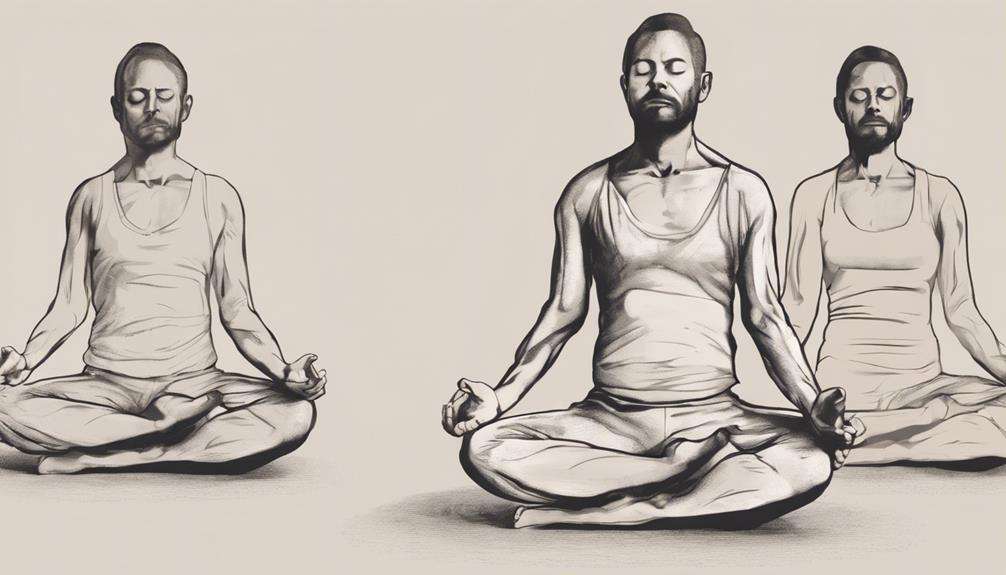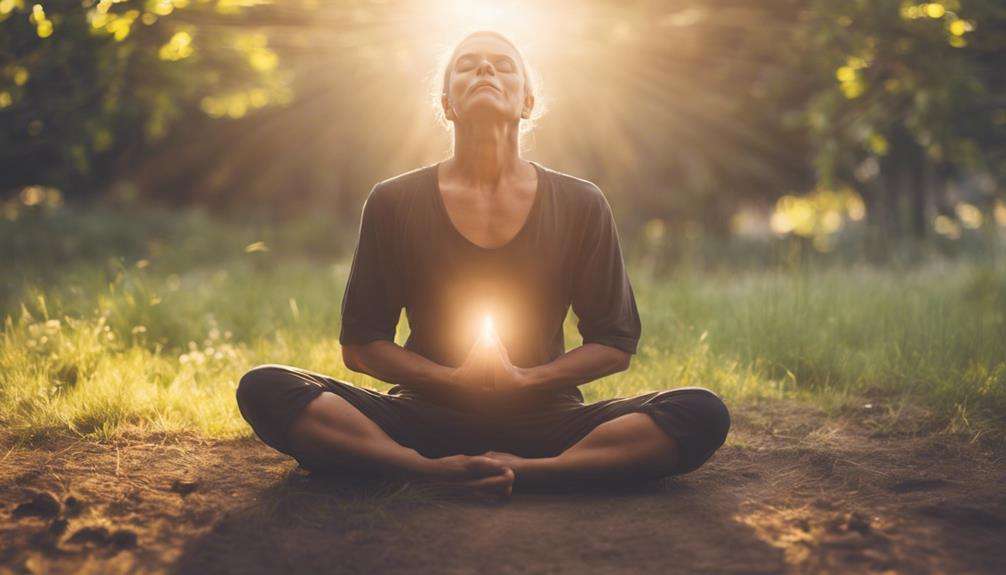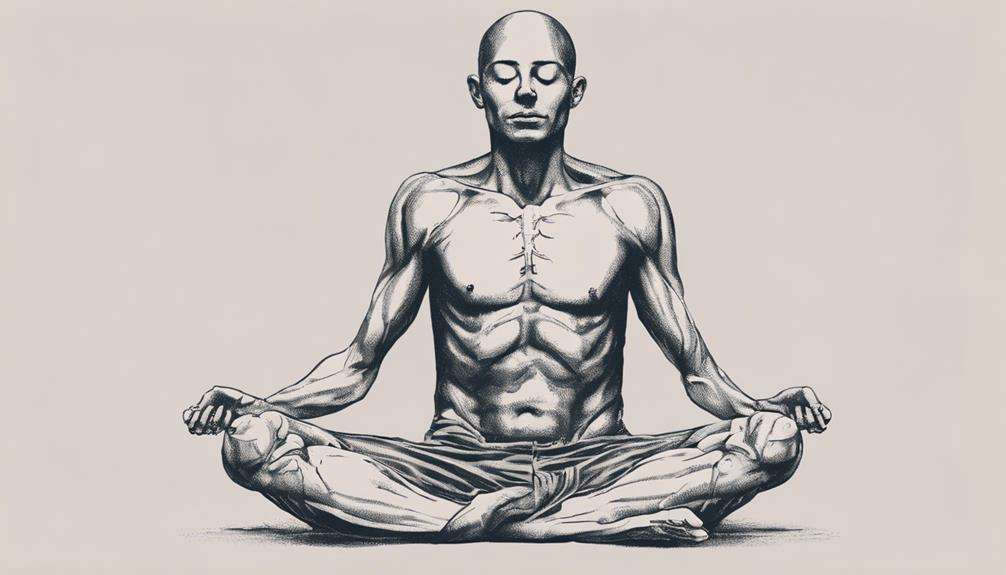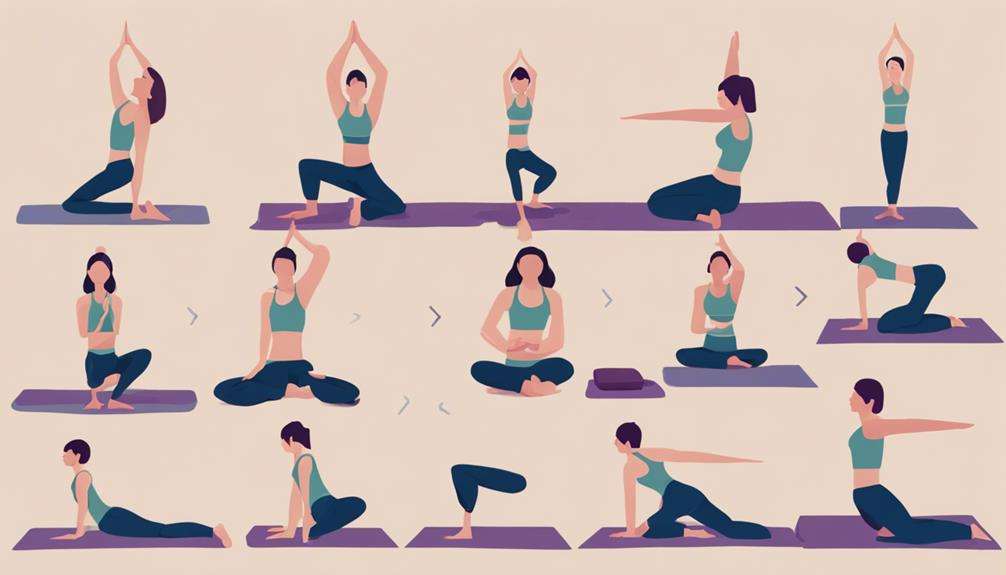As you start on the journey of exploring how mindful practices can reveal your respiratory power, consider this: the breath, often taken for granted, holds immense potential for transforming your well-being.
By embracing techniques that focus on your breathing patterns and rhythms, you open the door to a world where each inhale and exhale becomes a tool for enhancing your physical and mental equilibrium.
The mindfulness of breath extends far beyond mere oxygen intake, offering a gateway to a world where self-awareness and tranquility intersect seamlessly.
Key Takeaways
- Enhance respiratory power with yoga poses and pranayama techniques.
- Activate the parasympathetic nervous system for relaxation and balance.
- Improve lung capacity and mental clarity through mindful breathing practices.
- Transform respiratory health and quality of life with meditation and mindfulness.
Yoga Poses for Improved Breathing
Improve your respiratory power and enhance your well-being through the practice of specific yoga poses designed to boost breath control and lung capacity. By engaging in mindful breathing exercises, you can reduce stress, increase your lung capacity, and promote a sense of calmness. Deep breathing techniques incorporated in yoga help you tap into the full potential of your breath, allowing for better oxygenation of your body and a more profound sense of mindfulness.
Practicing yoga poses that focus on breathing, such as Pranayama and Anulom Vilom, offers a holistic approach to improving your respiratory health. These exercises not only enhance your lung capacity but also aid in increasing oxygen intake, supporting better respiratory function. Through regular practice, you can experience reduced stress levels, improved energy, and a clearer mind. Embracing these mindful practices can lead to a healthier respiratory system and a more balanced state of being.
Breath Control Techniques in Yoga
Explore the transformative power of breath control techniques in yoga to deepen your mind-body connection and enhance your overall well-being. Incorporating pranayama techniques into your yoga practice allows you to harness the full potential of your breath for physical and mental benefits.
Here are some key breath control techniques in yoga:
- Kapalabhati pranayama: This technique involves rapid and forceful exhalations followed by passive inhalations. It helps cleanse the respiratory system, increase oxygen supply, and energize the body.
- Anulom Vilom pranayama: Also known as alternate nostril breathing, this practice focuses on balancing the energy channels in the body. By alternating the flow of breath between the nostrils, it promotes harmony and relaxation.
- Bhramari pranayama: The humming bee breath technique involves making a humming sound while exhaling. It calms the mind, reduces stress, and creates soothing vibrations that resonate throughout the body.
Diaphragmatic Breathing Benefits

Engage your diaphragm muscle for deep, slow breaths to reveal a myriad of benefits associated with diaphragmatic breathing.
This intentional breathing technique not only increases your oxygen intake and enhances lung function but also plays an essential role in stress reduction.
By practicing diaphragmatic breathing, you activate the body's relaxation response, leading to a decrease in heart rate and a sense of overall relaxation.
Studies have shown that this type of breathing can greatly reduce anxiety levels and promote emotional regulation.
Additionally, diaphragmatic breathing can improve mental clarity by ensuring your brain receives an adequate oxygen supply.
By prioritizing deep breaths that engage the diaphragm, you empower yourself to tap into a natural mechanism for achieving both physical and emotional well-being.
Make diaphragmatic breathing a regular practice to reveal its full potential in enhancing your overall health and vitality.
Mindful Breathing Practices in Yoga
Mindfully incorporating breathing practices into your yoga routine can greatly enhance both your physical and mental well-being. When you engage in mindful breathing techniques during yoga, you tap into the Power of Mindful Breathing, which goes beyond just the physical aspect of the practice.
Here are five key benefits of incorporating mindful breathing into your yoga sessions:
- Mindful breathing techniques activate the parasympathetic nervous system, reducing the stress response in your body.
- Breathing exercises in yoga help regulate energy flow, promoting relaxation and inner peace.
- By activating the parasympathetic nervous system, mindful breathing fosters a sense of calm and balance within you.
- Mindful breathing in yoga improves concentration, mental clarity, and overall focus during your practice.
- Regular practice of mindful breathing can enhance your lung capacity, support respiratory health, and deepen the mind-body connection for a holistic well-being experience.
Pranayama for Respiratory Strength

Enhancing your respiratory strength through the practice of Pranayama involves focused breath control techniques aimed at optimizing your lung function and overall respiratory well-being. Pranayama, a yogic tradition of controlled breathing, offers a variety of breathing techniques like Kapalabhati, Anulom Vilom, and Bhramari that not only enhance lung capacity but also promote mindful breathing.
By engaging in Pranayama, you can't only strengthen your respiratory muscles but also experience stress reduction, improved emotional regulation, and inner balance through the power of your breath.
These breathing practices help in cleansing your respiratory system, increasing oxygen intake, and boosting your energy levels. Regular Pranayama sessions can lead to better overall respiratory health, heightened mindfulness, and a profound sense of inner harmony.
Enhancing Lung Capacity Through Yoga
By incorporating deep breathing techniques and specific yoga poses designed to strengthen your lungs, you can enhance your lung capacity greatly.
Practicing pranayama and focused breathing exercises not only expand your lung capacity but also improve the efficiency of your respiratory muscles.
Research suggests that regular yoga practice can elevate essential lung capacity and oxygen absorption, leading to better overall respiratory health.
Deep Breathing Techniques
Engage your diaphragm fully during deep breathing techniques in yoga to expand your lung capacity effectively. Diaphragmatic breathing in yoga promotes better oxygen exchange and blood circulation.
Pranayama techniques in yoga help improve respiratory efficiency and increase energy levels. Regular practice of deep breathing in yoga can enhance overall lung function and respiratory health.
Yoga deep breathing exercises can reduce stress, calm the mind, and improve mental focus.
- Engage diaphragm fully for effective lung capacity expansion
- Promotes better oxygen exchange and blood circulation
- Enhances respiratory efficiency and increases energy levels
- Improves overall lung function and respiratory health
- Reduces stress, calms the mind, and enhances mental focus
Yoga Poses for Lungs
Try incorporating specific yoga poses into your routine to boost your lung capacity and enhance respiratory function.
Yoga poses like Pranayama, Kapalabhati, and Bhastrika are known to improve lung capacity and overall respiratory health. These poses help increase oxygen intake, strengthen respiratory muscles, and enhance lung function.
Techniques such as Anulom Vilom and Ujjayi breathing promote deep breathing, which can expand lung capacity and improve breathing efficiency.
Research shows that practicing yoga can be beneficial for managing respiratory conditions like asthma and COPD. By integrating yoga for lungs into your daily regimen, you may experience better breathing patterns, reduced stress levels, and heightened energy levels.
Deep Breathing Exercises in Yoga

Explore the transformative world of deep breathing exercises in yoga, where the rhythm of your breath guides you towards enhanced respiratory power and inner calm. Deep breathing in yoga goes beyond just filling your lungs; it involves expanding the diaphragm to increase oxygen intake and promote relaxation.
Through these exercises, you activate the parasympathetic nervous system, reducing stress and bringing a sense of calm to your mind. This practice can lead to improved lung capacity, better respiratory function, and an overall boost in well-being. Regular deep breathing techniques not only help in emotional regulation, reducing anxiety, and enhancing mental clarity but also aid in cultivating mindfulness, presence, and inner peace.
- Deep breathing expands the diaphragm for increased oxygen intake and relaxation.
- Activates the parasympathetic nervous system, reducing stress and calming the mind.
- Improves lung capacity, enhances respiratory function, and boosts overall well-being.
- Helps regulate emotions, reduce anxiety, and improve mental clarity.
- Aids in developing mindfulness, presence, and inner peace.
Meditation for Better Breathing
Explore how practicing meditation can significantly enhance your breathing by fostering a deeper awareness of breath patterns and promoting diaphragmatic breathing for improved respiratory function and overall well-being.
Mindful breathing during meditation allows you to focus on the present moment, connecting with your breath and promoting a relaxation response that reduces stress and anxiety. By honing in on breath awareness, you can optimize oxygen intake, strengthen respiratory muscles, and increase lung capacity over time.
Techniques like focused breathing and body scans in meditation help you attune to your breath patterns, encouraging deep, diaphragmatic breathing that supports better respiratory health. Incorporating meditation into your daily routine can lead to long-term benefits, such as lower heart rate, reduced stress levels, and improved overall well-being.
Embrace the power of meditation for better breathing, and witness how this practice can transform your respiratory health and enhance your quality of life.
Frequently Asked Questions
What Do You Practice as Mindfulness of Breathing?
When practicing mindfulness of breathing, you focus on breath sensations, count breaths, and observe without judgment. This practice promotes calmness, enhances focus, reduces stress, and strengthens the mind-body connection. Deep breathing aids in relaxation and boosts respiratory health.
What Is the Power of Mindful Breathing?
Mindful breathing holds the power to bring stress relief, improve focus, boost energy, calm your mind, balance emotions, increase oxygen intake, trigger relaxation responses, enhance mind-body connection, optimize performance, and support respiratory health.
What Are 3 Examples of What Mindful Breathing Can Do for the Body?
When you practice mindful breathing, you invite stress relief, increased focus, and improved digestion into your life. Your body responds with a calm mind, balanced hormones, and enhanced energy. Embrace this practice for holistic wellness.
How Can I Improve My Mindful Breathing?
To improve your mindful breathing, try various breathing techniques like diaphragmatic breathing and square breathing for stress relief and focus. Explore meditation benefits for mind-body connection, energy regulation, and anxiety management. Practice relaxation methods to enhance breath awareness and improve overall well-being.
Conclusion
As you continue to unleash your respiratory power through mindful practices, envision yourself standing tall and strong like a tree swaying gently in the breeze.
Feel the deep roots of your breath grounding you, providing stability and strength.
Embrace the peace and clarity that comes with each mindful inhale and exhale, allowing yourself to release any tension or stress.
Trust in the power of your breath to guide you towards a more balanced and harmonious life.






